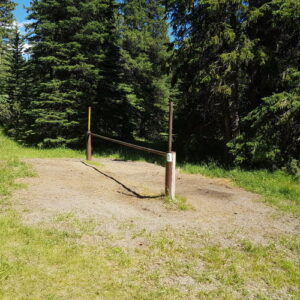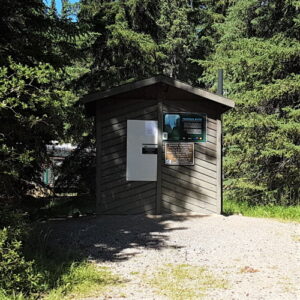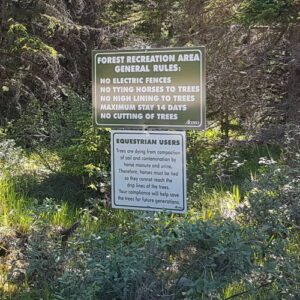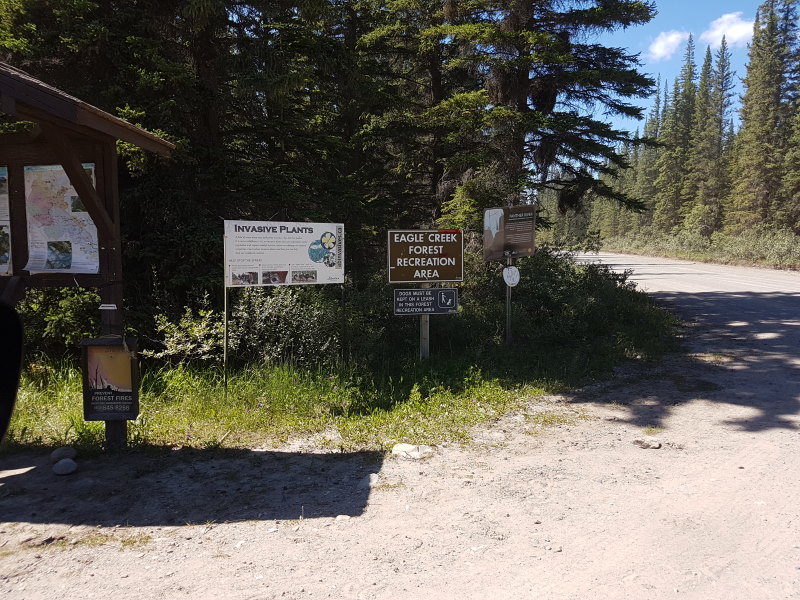Ah, sloppy seconds. Long a staple of frat boy delinquency, in the world of first come (snicker), first served camping they’re a necessity. As in, Plan B. Because when you’re hauling a fully loaded SUV and travel trailer to the middle of nowhere, you damn well want to be sure you get a campsite.
This was on my mind as we planned our second, apparently annual, trip to Ya Ha Tinda to do some equestrian camping with my aunt and uncle. We’d first gone to this gorgeous but remote oasis tucked into the eastern slopes of the Canadian Rocky Mountains last July. With COVID-19 restrictions loosening, it was time for another visit if only to be around someone, anyone, other than ourselves.
I was doing pre-trip research, making sure there would be space for us should we brave the gravel backroads again. Campgrounds across the province were open but not entirely so. And with so many eager people looking to escape their pandemic cabin fever, it was possible we’d arrive at Ya Ha Tinda only to be forced to turn around and leave. Not good.
Thankfully, the Friends of the Eastern Slopes Association (FOESA), the group that operates Bighorn Campground, our destination, shared some information about new restrictions on their website. Among this information was a statement indicating that they would post a sign at the entrance to Ya Ha Tinda Ranch if Bighorn Campground was at capacity. Potential campers could instead turn around and try Eagle Creek Campground rather than driving the remaining four kilometres to Bighorn.
That’s not much travel savings, granted. After an hour of bumpy, dusty, twisty, and turny gravel roads, avoiding an additional four kilometres is underwhelming. But, hey, better than nothing. What’s was more shocking about this information, though, was that there is another campground very near Bighorn. I had no idea.
We did decide to go, settling on a Monday to Wednesday timeframe assuming these would be the least busy days of the week. We were right and there was room for all of us at Bighorn. Not ample room, but enough to avoid stress. Or turning back.
As we approached the famed ranch’s eastern boundary, sure enough we passed Eagle Creek Campground. I’d not even noticed it last year, no doubt too focused on not destroying our vehicle and/or trailer while getting there. I immediately made a mental note to return during our stay and do a little recognizance of the place in case a Plan B is needed on future adventures to this part of Alberta. Here’s my report.
Eagle Creek Campground is very much like Bighorn Campground and yet not. Both are operated by FOESA and not surprisingly both cater to the equestrian crowd. Both are free, though donations to FOESA are appreciated in lieu of campground fees. And both are rough, rustic campgrounds with very limited services provided.
Located just outside the eastern boundary of Ya Ha Tinda Ranch, Eagle Creek Campground is still within full forest cover whereas Bighorn Campground, though having trees, is surrounded by pasture/meadow. As such, the biggest difference between the two campgrounds is the view. Unlike at Bighorn where some truly incredible views are available to most campers, the majority of campsites at Eagle Creek have no, or obstructed mountain views.
Take that as you may. You certainly didn’t drive all the way to Ya Ha Tinda to sit at your campsite. Well, I hope you didn’t. A short walk or ride to the open will get you those views. They just won’t be waiting for you the second you step out of your trailer in the morning.
That said, it appeared to me that a new western, extension of the campground has been opened up into a lesser treed area. Although very rough (it’s essentially crown land camping) this little loop of the campground has slightly more open vistas with visible mountains.
The Red Deer River passes along the southwestern boundary of Eagle Creek Campground and a handful of campsites back onto it. These are the gems if you ask me and the diamond of those gems is … being used by the campground supervisor. The perks of management.
The remaining campsites are a mishmash of fully treed and partially treed spots strewn throughout the boundaries of the campground. There are no numbered sites here, you just grab a “spot” and set up shop. What constitutes a site is primarily determined by the presence of makeshift stone firepits and metal (or wooden) tie-offs for your horses. The latter of which do have numbers.
Some of these campsites are easily identified being such by being located immediately next to the winding road through the campground. Others are more mysterious, with dirt paths leading to them further into the woods. It’s equal parts “this is kinda cool” and “wtf?”
 The presence of the various tie-off structures alludes to the dominance of equestrian campers in the area. However, while Bighorn has several larger, metal stalls to stow and feed your ride overnight, none such facilities exist at Eagle Creek. This is the slums of back country horse camping, if you will.
The presence of the various tie-off structures alludes to the dominance of equestrian campers in the area. However, while Bighorn has several larger, metal stalls to stow and feed your ride overnight, none such facilities exist at Eagle Creek. This is the slums of back country horse camping, if you will.
 Although Eagle Creek Campground is obviously catering to horseback riders, there is nothing posted that excludes non-horse campers from using it. In fact, some of the campsites appear to be regular sites with no horse structures in their immediate vicinity. Bighorn has a small, segregated area for non-horsers whereas Eagle Creek just seems to let anyone camp anywhere. Common courtesy would suggest you don’t gobble up sites with horse ties if you’re not going to use them.
Although Eagle Creek Campground is obviously catering to horseback riders, there is nothing posted that excludes non-horse campers from using it. In fact, some of the campsites appear to be regular sites with no horse structures in their immediate vicinity. Bighorn has a small, segregated area for non-horsers whereas Eagle Creek just seems to let anyone camp anywhere. Common courtesy would suggest you don’t gobble up sites with horse ties if you’re not going to use them.
 Another hint to the presence of horses are the signs all over the place directing you to the manure dump. That dump is basically a small looped road next to the campground where horse owners can dump their accumulated dung. Which they do. All around the loop. I don’t advise you setup your tent nearby.
Another hint to the presence of horses are the signs all over the place directing you to the manure dump. That dump is basically a small looped road next to the campground where horse owners can dump their accumulated dung. Which they do. All around the loop. I don’t advise you setup your tent nearby.

As for human waste, there are a handful of pit toilets scattered about the campground. In that “newer” area I mentioned there are some very rustic outhouses available. I didn’t venture into them for fear of unleashing the blackened souls of embittered, long dead gold rushers.
 In the regular portion of Eagle Creek Campground, the pit toilets are very much like those found at Bighorn. Nothing fancy and they get the job done, I suppose. I imagine RVers prefer their own, onboard facilities while tenters are just hardier by nature. I’m personally a fan of constipation.
In the regular portion of Eagle Creek Campground, the pit toilets are very much like those found at Bighorn. Nothing fancy and they get the job done, I suppose. I imagine RVers prefer their own, onboard facilities while tenters are just hardier by nature. I’m personally a fan of constipation.
The drop off to the river is actually quite steep. At Bighorn the campground is mostly at flood level but here at Eagle Creek you are many feet above water. That requires care when stumbling around your waterfront campsite after a few wobbly pops. It also limits the trails and exploring along the river which is often enjoyable for campers without horses (i.e. me).
The view is nonetheless pretty, and I wouldn’t hesitate to snag one of these campsites for my stay. Besides, the entire wilderness surrounding Eagle Creek Campground and into Ya Ha Tinda Ranch is full of awesome trails winding every which way up, down, and around the hills, mountains, and rivers of this gorgeous piece of Canada.
Not surprisingly, there is no cell service here. Or store. Or dump station. Or any luxury amenity you might be accustomed to. You don’t go all that way on gravel roads to experience pampering. It’s about nature and the less distraction the better.
 All in all, Eagle Creek Campground serves as an adequate second choice if Bighorn Campground is full. It’s a rustic campground with few amenities. I’ll wager it even gets a bit sloppy after a rain. I give it a modest 2.5 out of 5 Baby Dill Pickles.
All in all, Eagle Creek Campground serves as an adequate second choice if Bighorn Campground is full. It’s a rustic campground with few amenities. I’ll wager it even gets a bit sloppy after a rain. I give it a modest 2.5 out of 5 Baby Dill Pickles.
The real appeal of Eagle Creek is everything around the campground not the campground itself. For my dollar, Bighorn Campground is far more appealing simply because of the lovely, open views it affords most campers. But I wouldn’t turn around and go home if Eagle Creek Campground had the only available spots. This whole area is beautiful with far fewer people than the bigger name, closer-to-the-cities camping areas. Why not go for a ride … and a ride.










